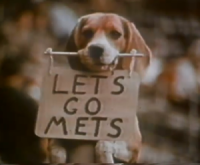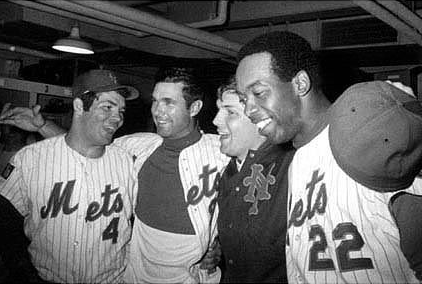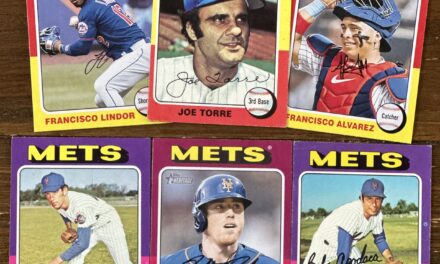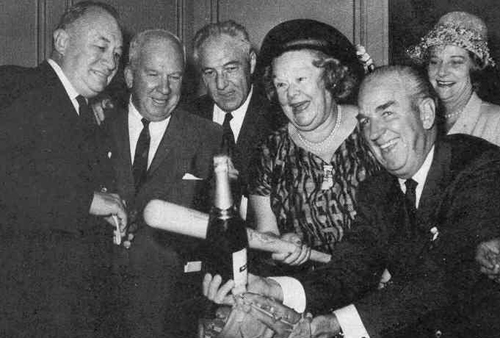
The New York Mets were founded in 1962 filling a void left by the departure of the Brooklyn Dodgers and New York Giants, both going to California, and leaving the nation’s largest city without a National League franchise. The very colors of the nascent team, blue and orange, are a throwback to the two teams that went west. They started the decade of the 60s as laughing stocks, finding ways to lose that confounded even hardened observers of the sport. It ended with glory and in a championship that may still stand as one of the most unlikely and wondrous of all time.
The name of the team is a shortening of the corporate name, the New York Metropolitan Baseball Club, Inc. Also, majority owner of the team Joan Payson, liked Mets because it was short and easy to fit in headlines. (Incidentally, she nearly named the team the Meadowlarks). But the early headlines were not at all complimentary as the new team floundered and set new standards for ineptitude and became known as the ‘lovable losers’ of New York sports.
The Mets made their debut on April 11, 1962 against the St. Louis Cardinals at Busch Stadium. They lost 11-4 on route to nine straight franchise opening losses. Their first win was at Forbes Field against the undefeated Pittsburgh Pirates, 9-1, on April 23. The team finished 1962 with an abysmal 40-120 record, the most losses by a major league team since 1899.
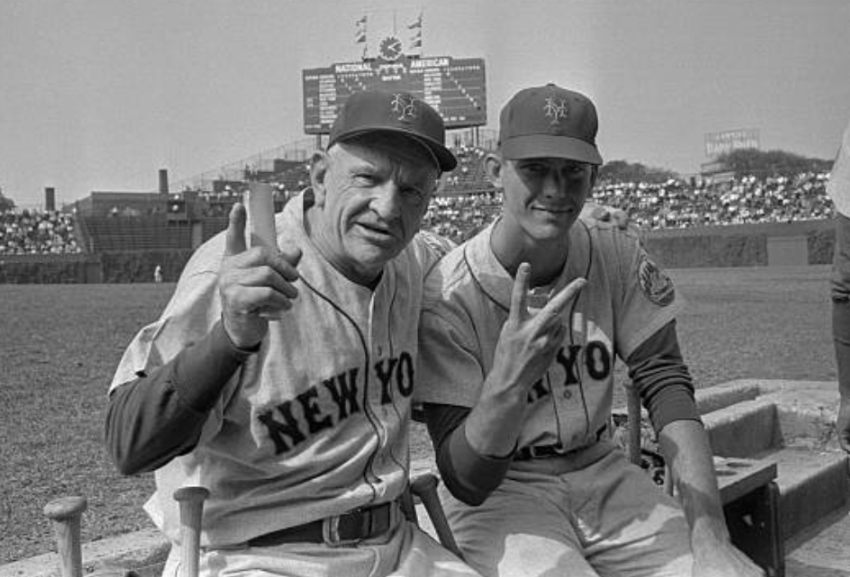
Their manager was Casey Stengel, the legendary New York Yankees manager who coined several catchy phrases to describe his ‘predicament’. “They’ve shown me ways to lose I never knew existed.” and “The only thing worse than a Mets game is a Mets doubleheader” are two of many.
The Mets played their first two seasons at the Polo Grounds before moving to Shea Stadium in 1964. They played their first game in the new stadium on April 17 in front of a sell-out crowd. The opponents were the Pirates and in the end, the Mets lost 4-3. Shea hosted its only All-Star Game in 1964.
In 1965, Wes Westrum took over as Mets manager. The Mets had four managers in the 1960s including Salty Parker who was an interim manager for 11 games in 1967. The 1965 team fared little better than the previous three 10th place squads going 50-112.
As the decade went on, New York was getting tired of all the losing and attendance suffered. Things improved slightly in 1966 where the Mets went 66-95, their first season without at least 100 losses. It was also the first time they didn’t finish in last place as they managed to finish ahead of the Cubs.
Some important seeds were planted in the 1967 season for the Mets. They acquired Hall-of-Famer Tom Seaver in a lottery. Jerry Grote and Bud Harrelson also joined the club, forming a trio of players that created a clubhouse atmosphere that did not accept losing as a culture. Seaver won the Rookie-of-the-Year award in 1967 and played in the first of his 11 All-Star Games.
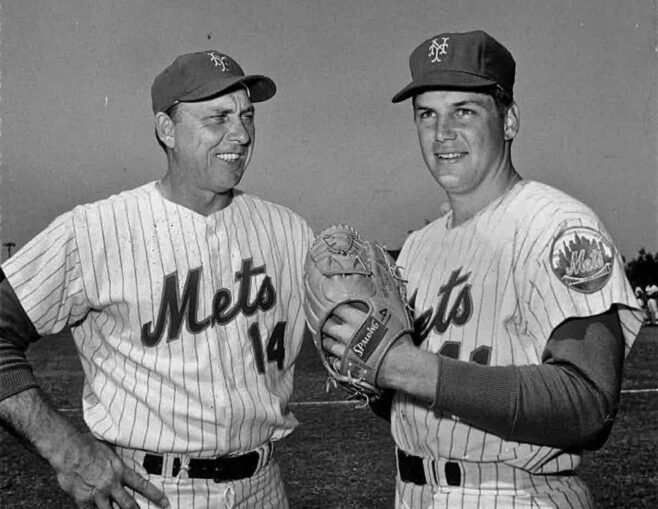
In 1968, Gil Hodges replaced Westrum as manager. More important pieces of the mosaic were added in 1968 including Jerry Koosman who had a spectacular rookie season winning 19 games. Cleon Jones had a much improved season and Tommie Agee came over in a trade. Despite the additions, the Mets finished in ninth place with a 73-89 record.
Just recalling the year ‘1969’, just saying the year aloud, engenders thoughts of miracles, surprises and happiness seldom if ever seen in sports prior to ’69 or since. It was the year the New York Mets came from the depths of mediocrity and losing to the pinnacle of the sports universe by winning the World Series.
The Mets languished for most of the 1969 season, but finished the season winning 38 of their final 49 games and won the newly formed National League East with 100 wins. They then swept the Atlanta Braves in the first ever NL Championship series.
The Mets were heavy underdogs to a Baltimore Oriole squad that won 109 games and featured stars like Frank Robinson, Jim Palmer, Brooks Robinson and future Mets manager Davey Johnson to name a few. But even after Tom Seaver lost game one, the Mets roared back to take the next four games to win the World Series in dramatic fashion using timely hitting, outstanding defense and terrific pitching. Quite a way to end a decade.
The Mets didn’t have a collection of superstars throughout the decade at least until Seaver arrived, but they did have their share of important players many of whom will appear in the list to follow. Here is the All-Decade team for the 1960s:
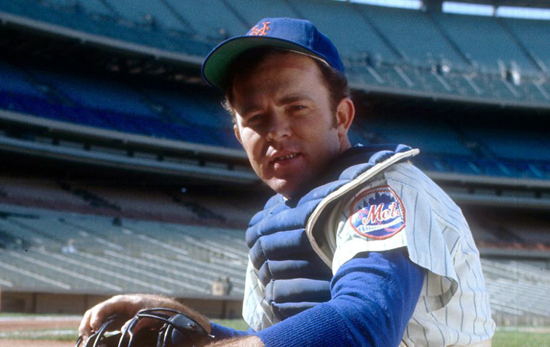
Jerry Grote, C
Grote arrived on the scene in 1966 as a 23-year-old entering his second full year in the majors. He would spend 11 years in a Mets uniform. Prior to 1966, the Mets had trouble finding a stable everyday catcher. This problem was solved with a trade with the Houston Astros that brought Grote to New York.
Jerry Grote was never the best hitting catcher in the game but was known for his defensive prowess and his ability to work with young pitchers. He did make the All-Star team in 1968, but had his best year offensively in 1969 stroking six home runs and knocking in 40. That year he caught every inning of the post-season showing how durable and dependable he was.
Towards the end of the 1960s, the Mets had several outstanding young pitchers. Some of the credit for their development must go to Grote. The pitchers all enjoyed throwing to him.
Honorable mention goes to Duffy Dyer who, despite being a part of the Mets for only two years in the 1960s was a solid back-up for Grote.

Ed Kranepool, 1B
Southpaw Ed Kranepool was a fixture for the Mets from the beginning of the franchise as he played his entire 18-year career with New York. He even appeared in three games for the inaugural 1962 team, but did not become the everyday first baseman until 1964. He was an All-Star in 1965.
Kranepool was a steady offensive contributor, but like Grote, was better known for his defense. His best offensive season was in 1966, when he hit 16 home runs and had 57 RBI. In 1969, Kranepool platooned with Donn Clendenon who gets honorable mention. Clendenon played most of the World Series in ’69 due to the plethora of left-handers the Orioles sent to the mound. He responded by hitting three homers and copping the MVP for the 1960 World Series.
Kranepool was a steady presence for the Mets, and his dependability and longevity with one team resulted in many referring to him as the Mets iron-man.
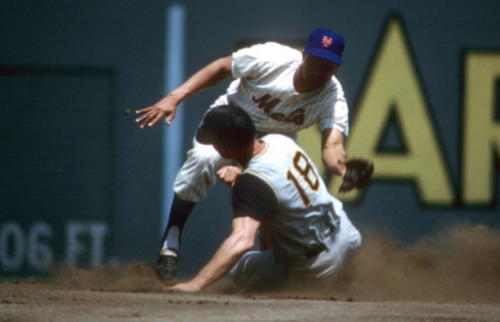
Ron Hunt, 2B
Ron Hunt made his major league debut at age 22 with the Mets in 1963. He finished second in Rookie-of-the-Year balloting that year to Pete Rose. The next year he was the first Met to be voted to the All-Star game as a starter. The game was played at his home park, Shea Stadium. He also made the All-Star team in 1966.
Hunt is considered by many as the first ‘great’ Met and one of the few bright spots on an otherwise below average team. In 1964, he hit a remarkable .303, made all the better in that he had little protection in the lineup.
In November 1966 Hunt and Jim Hickman were traded to the Los Angeles Dodgers for Tommy Davis and Derrell Griffith. Hunt’s career was all to short with New York, but was their first star second baseman.
Honorable mention goes to Ken Boswell who was the Mets primary second baseman of the late sixties. Although not known for power, he did strike two homers in the NLCS against the Braves to help the Mets sweep. He was also regarded as a clutch hitter for New York delivering hits in many crucial situations.
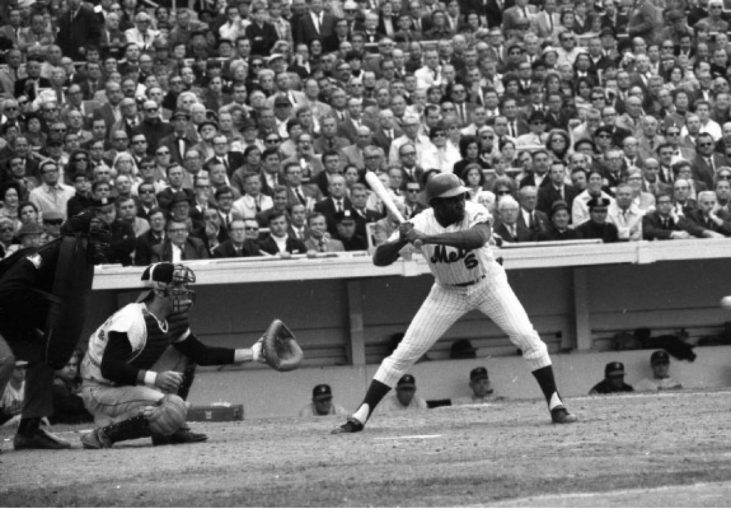
Ed Charles, 3B
Third base was more like a merry-go-round for the Mets in the 1960s as the team plugged in player after player at the position. All told, 41 different major leaguers manned the hot corner for New York but the one who is remembered most is Ed Charles.
Charles came to the Mets in 1967 in a trade with the Kansas City Athletics. The 34-year-old was in his sixth season when he arrived in Flushing. He had a poor 1967 season but played well in 1968 stroking 15 home runs and a career high 79 RBIs.
He hit his final career home run during the Mets NL East division clinching game. In the World Series, he scored the winning run in Game 2. After the Mets won the World Series, Charles decided to go out on top and retire.
Honorable mention could go to many, but Wayne Garrett gets the nod because although he made his mark for the Mets in the 1970s, his contributions in 1969 were still important as he platooned with Charles for much of the year.
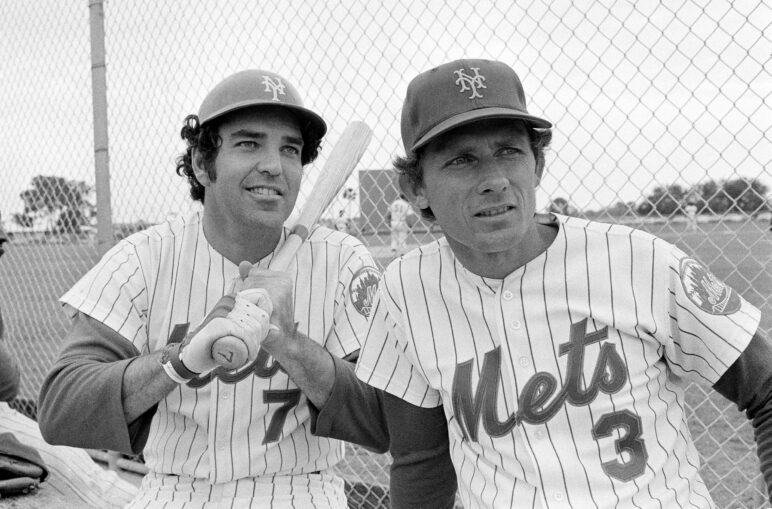
Bud Harrelson, SS
Derrel McKinley Harrelson, or simply Bud as he is better known, was the standard bearer for the shortstop position for most of the early history of the Mets. His playing career for New York spanned 13 years, from 1965-1977, and is by far the longest-tenured shortstop in team history. He came up as a 21-year-old-rookie in 1965 and was a mainstay at short for 13 years. Harrelson was awarded the starting shortstop position in 1967 and played there with sure handedness that would eventually lead to a Gold Glove an All-Star appearances in the 1970s. His lifetime fielding percentage was a very respectable .969.
He, along with Jerry Grote and Tom Seaver, are credited for changing the temperment of the Mets clubhouse in 1967 especially, not allowing the culture of losing to be tolerated. Although the switch-hitting Harrelson was a weak offensive player, his defense was sure enough to allow him to play everyday in a line-up filled with platoon players.
One of the most sure-handed infielders of his time, Harrelson was by far the best shortstop the Mets had in the 1960s, and he would go on to play much longer for the Mets owing to his durability
Honorable mention goes to Roy McMillan who was a defensive specialist for the Mets in the mid-sixties as his career wound down.
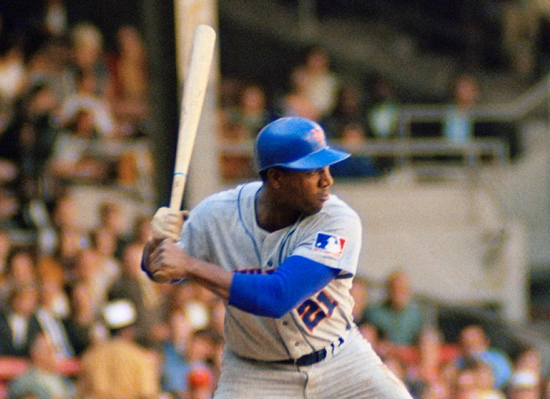
Cleon Jones, LF
Cleon Jones is an obvious pick here as he was the hitting star of the 1969 season, hitting .340 with 12 home runs and a career high 75 RBIs. He, like Kranepool, was also known for his longevity with the Mets as he played all but one of his 13-year career with New York.
Jones started with the Mets in 1963 as a 20-year-old rookie. He was awarded the starting center field in 1966 but lasted only one year in center. The following season he was moved to left to make room for his childhood friend and former Gold Glover Tommie Agee whom the Mets acquired in a trade with the Chicago White Sox.
On July 30, 1969, Jones was pulled from a game by manager Gil Hodges for lack of hustle. It turned out to be a turning point for the Mets who went on an impressive run after the Jones incident to help them win the NL East.
And of course, Jones caught the final out of the 1969 World Series, dropping to one knee which is one of the most iconic images of not only the Series, but the Mets franchise as well.
Honorable mention goes to the Mets original slugger, Frank Thomas, who in 1962 slugged 34 home runs and knocked in 94 RBIs for the fledgling Mets.
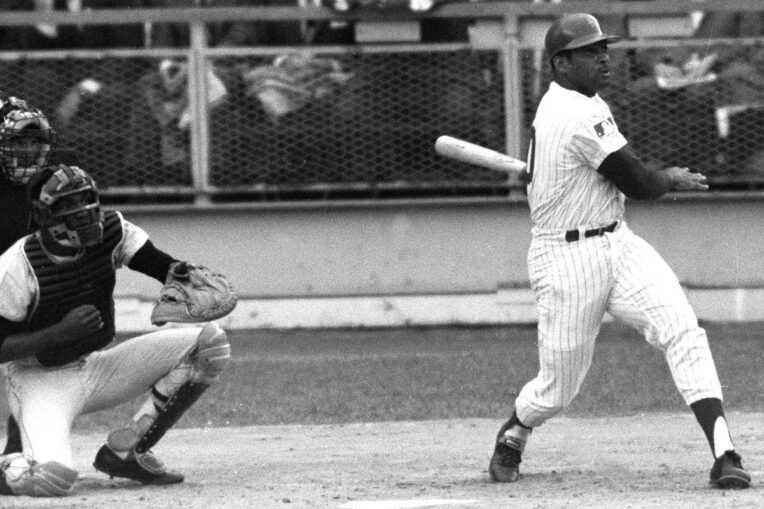
Tommie Agee, CF
Agee only played for two years in the decade of the 60s but nevertheless deserves to be included in this list if for nothing more than what he did in one game in the 1969 World Series.
In Game 3, he had what Sports Illustrated called the greatest single performance by a center fielder in World Series history. He hit a lead-off home run off of Jim Palmer to give the Mets the early lead but then made two spectacular catches off the bats of Elrod Hendricks in the fourth inning and Paul Blair with the bases loaded in the seventh. Agee potentially saved five runs from scoring. Agee was arguably one of the Mets heroes during the Series.
During the regular season in ’69, Agee batted leadoff and had a solid year hitting 26 home runs and 76 RBIs, leading the team in both categories. His defense was steady and at times excellent.
Honorable mention goes to the first Mets centerfielder Jim Hickman. He holds several distinction with the Mets including the first Met to ever hit for the cycle and the first Met to hit three home runs in a game as examples. He also hit the last home run ever at the Polo Grounds.
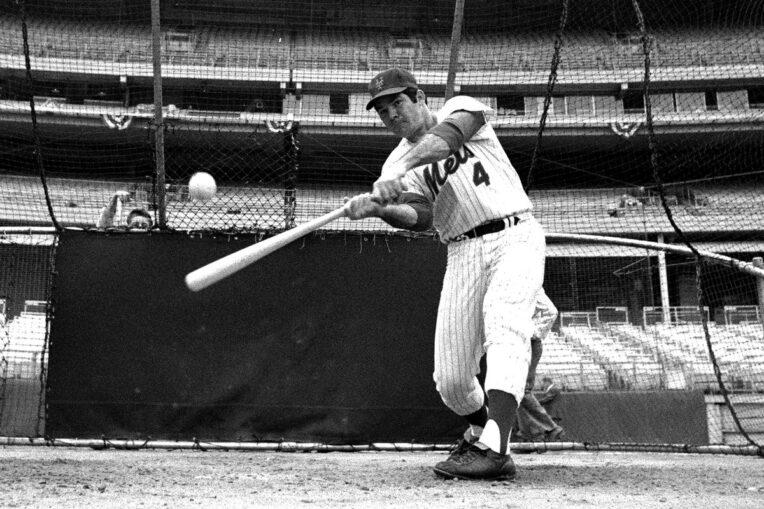
Ron Swoboda, RF
When he came up to the Mets, Ron Swoboda was nicknamed “Rocky”, a denigrating name meant to describe his rocky play in the outfield. He later would use his glove to help the Mets achieve glory in 1969.
Swoboda came to the Mets in 1965 as a 21-year-old rookie and had a good freshman season hitting a career high 19 home runs and knocking in 50. He was a role-player for most of the decade, alternating between the outfield and first base. He eventually ended up in right field and platooned with Art Shamsky for most of the ’69 season. His defense was on the improve as he had 15 outfield assists in 1968.
Swoboda did not play in the 1969 NLCS against the Braves. In the World Series against Baltimore he made an iconic catch in game 4 to end a rally. It was hit off the bat of Brooks Robinson in the ninth inning of game 4 as Swoboda stretched almost horizontally, just inches off the ground, dove to make the grab. The Mets eventually won the game, 2-1, in 10-innings.
Swoboda also stroked the game winning RBI in game 5, his only RBI of the series. Overall, he batted .400 in the World Series.
Honorable mention goes to Art Shamsky who, while platooning with Swoboda, hit 14 homers and drove in 44 while hitting .300. In the NLCS he played all three games, hitting a robust .538 leading all batters.
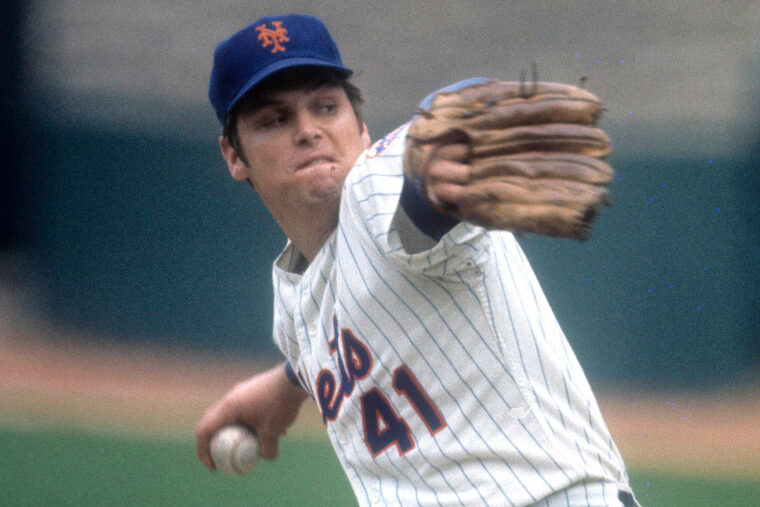
Tom Seaver, RHP
What else can be said about perhaps the greatest right-hand pitcher in history? Summing up Tom Seaver can be done in one stat: he is only one of two pitchers in MLB history with over 300 wins, 3000 strikeouts and an ERA below 3.00, with Walter Johnson the other. He pitched in his prime in the 70s, but had many great moments in the 60s as well.
Seaver came to the Mets in 1967 and went 16-13, good enough to named an All-Star and National League Rookie-of-the Year. The All-Star appearance was the first of eleven visits to the mid-summer classic the Hall of Famer would make.
Seaver was the Opening Day starter for the Mets in 1968. He won 16 games again in 1968 and struck out 205 batters, the first of nine consecutive years Seaver amassed over 200 Ks. In 1969, Seaver won a league-high 25 games and his first National League Cy Young Award. He also finished runner-up to Willie McCovey for the League’s Most Valuable Player Award.
In the playoffs, Seaver won game one of the NLCS defeating Phil Niekro and the Braves. He also started game one of the World Series but lost 4-1 to Mike Cuellar and the Orioles. He bounced back in game four with a complete game, 10-inning victory, 2-1. The Mets went on to clinch in game 5. after the ’69 season, Seaver was presented with the Hicock Belt as the top professional athlete of the year and Sports Illustrated magazine’s Sportsman of the Year award.
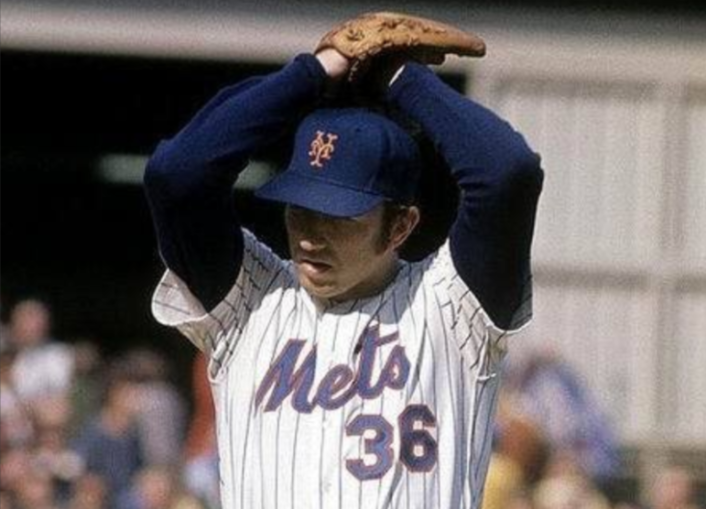
Jerry Koosman, LHP
Tom Seaver got most of the accolades, but it was Jerry Koosman who was needed in the clutch in several instances in the 1969 season and post-season. Many pundits called Koosman the ‘go-to’ pitcher when the Mets needed a win. That, along with his 12-year stint with the Mets filled with mostly very good pitching has made Koosman one of the greatest left-handed pitchers in Mets history.
Koosman broke into the Mets rotation in 1968 and had a standout rookie season going 19-12 with a 2.08 ERA. He earned the first of consecutive All-Star berths and earned the save in the 1968 game. He finished second behind Johnny Bench in Rookie-of-the-Year balloting.
In 1969, Koosman posted a 17–9 record with a 2.28 ERA and 180 strikeouts in another stellar season. He was the pitching star of the World Series winning an important game two after the Orioles defeated Seaver and the Mets in game one. He returned in game five and found himself quickly in a 3-0 hole. But the Mets battled back to take the lead and Koosman went all nine innings to secure the game and the championship. Cleon Jones, after catching the fly-ball off the bat of Davey Johnson to secure the Series’ final out, gave the game ball to Koosman.
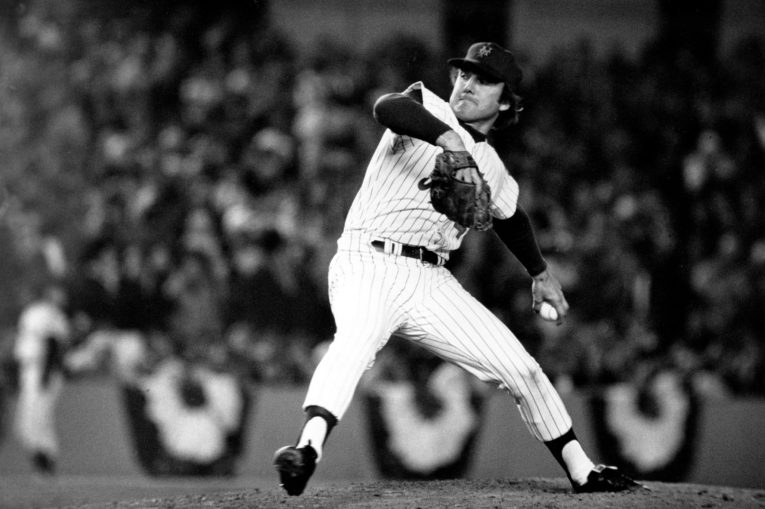
Ron Taylor and Tug McGraw, Bullpen
Hard to distinguish between the two late sixties stars, Taylor and McGraw helped steady the bullpen and together recorded 25 saves between them in the 1969 season. Taylor was the first great reliever for the Mets and was used in several roles including part-time closer. Taylor won nine games out of the bullpen in 1969 and also had 13 saves. He was the only Met on the roster with prior post-season experience as he was a member of the 1964 St. Louis Cardinals World Series winning team. This experience paid off as he did not allow a single run in the 1969 postseason, winning a game in the NLCS (game 2) while saving another (game 1). He also recorded a save in game two of the World Series.
McGraw was not used much in the post-season in 1969. He made only one appearance that in game two of the NLCS and pitched well. In the regular season he was strong going 9-3 with a 2.24 ERA and 12 saves. He was originally a starter, but there was a logjam at starting pitching and Gil Hodges decided to move him to the pen where he quickly became dominant. He raised his level another notch in the 70s leading the Mets to the pennant in 1973 with a rallying cry for the ages, “Ya Gotta Believe.” Taylor probable gets the slight nod here due to his postseason prowess but McGraw’s presence and effect on the team were undeniable.
For more on the 1969 Miracle Mets please click here to read my account of this truly remarkable team.
